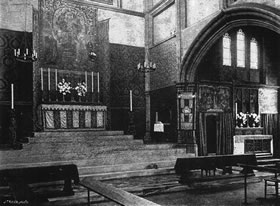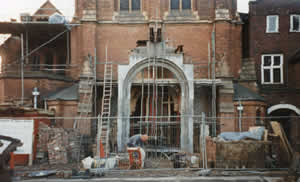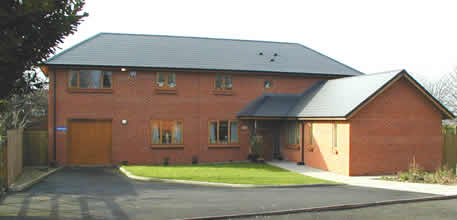History
The most recent history of All Saints Church can be found on our Facebook site, but history going back beyond the most recent decades is below split across several pages.
Small Heath Parish 1993 - 2002
The result of all these changes on the Church communities of Small Heath was of course dramatic with congregations in each of the parishes falling to very small numbers. Discussions took place as early as the 1970's about bringing
the parishes of St Aidan, St Oswald, St Gregory and St Andrew together and for a period from the mid 1980's they became a Group of parishes. However the effects of the changes continued, St Andrew's church was demolished and its
area divided between St Martin in the Bull Ring and St Aidan. In 1992 the remaining three parishes were amalgamated into a single parish, though still with three church buildings.
On 17th November 1992 the amalgamation of
St Aidan, St Gregory and St Oswald was confirmed at the Court of Buckingham Palace.
From 1994 decisions were taken that there was need for only one set of buildings and a very extensive process of analysis and consultation
was undertaken by the parish to determine the Way Forward. The outcome was a radical set of decisions which were based in a new Mission Statement and a Parish strategy known as the Way Forward:
- To be involved in four new ways in the community together with other local Churches and community organisations
- To close and sell St Gregory the Great and its vicarage
- To close and sell the church, hall and vicarage at St Oswald of Worcester
- To redevelop the St Aidan site
- To rename the parish as All Saints
- To bring into the parish the remainder of the former St Andrew's parish, now known as Bordesley Village
- To purchase a new Vicarage in Bordesley Village
Each of these required very extensive legal, consultative and financial proceedings, which were largely completed by the end of 1998.
The decision to redevelop St Aidan's was based on its location in the parish and on  its potential for
redevelopment. The changes in the area in the 1970's had left the building isolated, with its entrance obscure and in poor condition. The proposal was to retain as much as possible of its character but to adapt it for its present
and present and future mission. This involved the reversal of the direction of worship, making the former baptistery into a beautiful new sanctuary; removing the old high altar which would become the new entrance onto Herbert Road,
creating a new inner entrance area with a beautiful hall above, restoring all the facilities of the building, enlarging the Lady Chapel and converting the vicarage to become a "Place of Welcome" (which has since
been renamed "All Saints House") for the community with five flats above.
its potential for
redevelopment. The changes in the area in the 1970's had left the building isolated, with its entrance obscure and in poor condition. The proposal was to retain as much as possible of its character but to adapt it for its present
and present and future mission. This involved the reversal of the direction of worship, making the former baptistery into a beautiful new sanctuary; removing the old high altar which would become the new entrance onto Herbert Road,
creating a new inner entrance area with a beautiful hall above, restoring all the facilities of the building, enlarging the Lady Chapel and converting the vicarage to become a "Place of Welcome" (which has since
been renamed "All Saints House") for the community with five flats above.

These proposals were welcomed by the congregation and local community and supported by the Diocesan Advisory Committee, the Council for the Care of Churches, English heritage and others, but opposed by the Victorian Society and by a minority on the City Planning Committee. A very difficult struggle ensued which included in mid 1998 a Consistory Court brought about by the Victorian Society after Listed Consent had been granted. The Chancellor granted a faculty and in noting that the Victorian Society had acted "arrogantly, unreasonably and without common sense", awarded costs against them.
 In November 1998, a new working party was formed called the
Next Steps group whose main task was to lead the project into its next phase - physical development. After considerable fundraising the former vicarage was converted in August 1999 into a community centre initially called The Place
of Welcome (later renamed All Saints House).
In November 1998, a new working party was formed called the
Next Steps group whose main task was to lead the project into its next phase - physical development. After considerable fundraising the former vicarage was converted in August 1999 into a community centre initially called The Place
of Welcome (later renamed All Saints House).
Hope was high as the development progressed. The physical changes that took place during a twenty two month development project (July 1999 - April 2001) included:
In the church
- Moving the interior around by 180 degrees so that the congregation faces the opposite direction
- creating a new east entrance of Herbert Road
- putting a beautiful new hall above the new entrance area and enclosing the former chancel arch in glass
- making new rooms for vestry and storage space
- renewing roof and brickwork inside and outside
- installing a new heating, lighting and electricity system
The former vicarage
- The ground floor has kitchen and café area suitable for activities such as lunch clubs, coffee mornings and youth group events.
- The first floor has a number of rooms - suitable for meetings or leasing to external organisations.
- The second floor was laid out as an apartment with kitchen and bathroom facilities, but subsequently leased to Birmingham Churches Together.
The old Hall
 The hall was a large building behind the church. In the past it was used for dances, performances and other events
by the local community. More recently utilisation of the hall was minimal, it was expensive to heat and maintain, was an easy target for vandals and it had become an unattractive building taking up a substantial amount of land
that could have better use.
The hall was a large building behind the church. In the past it was used for dances, performances and other events
by the local community. More recently utilisation of the hall was minimal, it was expensive to heat and maintain, was an easy target for vandals and it had become an unattractive building taking up a substantial amount of land
that could have better use.
 In 1999 the hall was demolished and replaced by a new Clergy House with a small garden, drive and
parking space (shown in this image). The Clergy House is now occupied by the current parish priest of All Saints, Fr. Julian.
In 1999 the hall was demolished and replaced by a new Clergy House with a small garden, drive and
parking space (shown in this image). The Clergy House is now occupied by the current parish priest of All Saints, Fr. Julian.